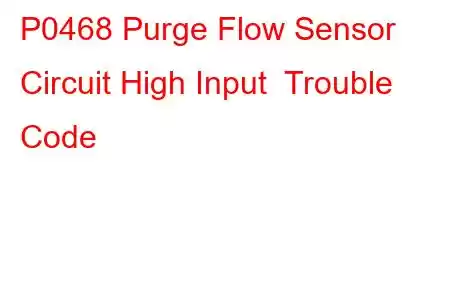P0468 Purge Flow Sensor Circuit High
OBD-II Trouble Code Technical Description
Purge Flow Sensor Circuit High
What does that mean?
This generic powertrain/engine diagnostic trouble code can typically apply to all OBDII equipped engines, but shows up more often in certain Mercedes Benz vehicles.
The Purge Flow Sensor (PFS) is usually found mounted in the evaporative fuel system, also known as the charcoal canister, close to the fuel tank or possibly even in the top of the fuel tank / fuel pump module. The PFS converts the EVAP system pressure into an electrical signal for the Powertrain Control Module (PCM).
The PCM receives this voltage signal to determine how much fuel it will put into the engine along with the fuel entering the intake manifold from the EVAP system. This code is set if this input does not match normal engine operating conditions stored in the PCM’s memory, even for a second, as this diagnostic trouble code demonstrates. It also looks at the voltage signal from the PFS sensor to determine if it is correct at initial Key On.
P0468 is set when the voltage at the sensor stays above a set level (usually over 4.8V) for too long a period of time. This code is usually considered to be an electrical circuit issue.
Troubleshooting steps may vary depending upon manufacturer, type of PFS sensor and wire colors.
Severity & Symptoms
Severity in this case will be not severe. Since it is electrical failure, the PCM can compensate adequately for it.
Symptoms of a P0468 engine code may include:
Malfunction Indicator Lamp (MIL) illuminated Decrease in fuel economyPotential Causes
Typically the causes for this code to set are:
Short to power in the signal circuit to the PFS sensor - possible Open in the ground circuit at PFS sensor - likely Failed PFS Sensor - possible Failed PCM - unlikelyDiagnostic and Repair Procedures
A good starting point is always a technical service bulletin (TSB) search for your particular vehicle. The vehicle manufacturer may have a PCM flash/reprogram to cover this issue, and it pays to check on this before you find you’ve gone down a long/wrong path.
Next, locate the purge flow sensor on your particular vehicle. This sensor is usually found mounted in the evaporative fuel system, also known as the charcoal canister, close to the fuel tank or possibly even in the top of the fuel tank / fuel pump module. Once located, visually inspect the connector and wiring. Look for scraping, rubbing, bare wires, burn spots or melted plastic. Pull the connector apart and carefully inspect the terminals (the metal parts) inside the connector. See if they look burned or have a green tint indicating corrosion. Use electrical contact cleaner and a plastic bristle brush if cleaning of the terminals is needed. Let dry and apply electrical grease where the terminals contact.
If you have a scan tool, clear the diagnostic trouble codes from memory, and see if P0468 code returns. If it does not, then the connections were most likely your problem.
If the P0468 code does return, we will need to test the PFS sensor and its associated circuits. With the Key Off, disconnect the electrical connector at the PFS sensor. Connect a Digital Voltmeter black lead to the ground terminal at the PFS sensor wiring harness connector. Connect the red lead of the Digital Voltmeter to the power terminal at the PFS sensor wiring harness connector. Turn Key On Engine Off. Check manufacturer’s specifications; voltmeter should read either 12 volts or 5 volts. If not, repair the power or ground wire, or replace the PCM.
If the prior test passed, we will need to test the signal wire. With the connector still disconnected, move the red lead of the voltmeter from the power wire terminal to the signal wire terminal. The voltmeter should now read 5 volts. If not, repair the signal wire, or replace the PCM.
If all prior tests have passed and you continue to get a P0468, this would most likely indicate a failed PFS sensor, although a failed PCM could not be ruled out until the PFS sensor had been replaced. If unsure, seek assistance from a trained automotive diagnostician. PCMs must be programmed, or calibrated to the vehicle in order to be installed correctly.
Read: 48


